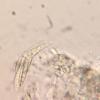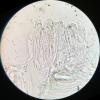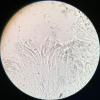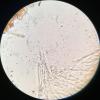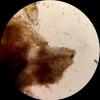
20-12-2025 15:47
Mirek GrycHi.These grew on pine wood that was heavily covere

18-12-2025 21:17
Pol DebaenstThe identification took me to Byssonectria deformi

15-12-2025 07:09
 Danny Newman
Danny Newman
indet. Rutstroemiaceae sp. on unk. fallen leavesMc

19-12-2025 10:10
Patrice TANCHAUDBonjour, récolte réalisée en milieu dunaire, a

18-12-2025 17:23
 Bruno Coué
Bruno Coué
Bonjour,je serais heureux d'avoir votre avis sur c

18-12-2025 18:07
Margot en Geert VullingsThese plumes were found on rotten wood.They strong

17-12-2025 18:35
 Michel Hairaud
Michel Hairaud
Bonjour à tous/Hi to everyone I am passing along

15-12-2025 15:48
 Danny Newman
Danny Newman
Melanospora cf. lagenaria on old, rotting, fallen
Karstenia rhopaloides?
Ethan Crenson,
01-12-2024 19:58
Hi all,
Found yesterday by a friend in a wooded park in the Bronx, NYC, on a fallen branch of hardwood (Quercus, Liquidambar, Liriodendron and Prunus are common in those woods).
Clearly erumpent through the bark with a grayish hymenium. Spores are clavate and 4-9 septate. They seem fragile, prone to breaking. 19.5-38.1 x 4.8-6.3µm.
Asci and paraphyses surrounded by a glutinous epithecium which stains blue-green in IKI. Because of the staining of the epithecium it is difficult to tell if the ascus tip blues as well. Still working on that.
Paraphyses slightly constricted at the septa, ends clavate or swollen.
My sense is that this is Karstenia rhopaloides. The spores seem too narrow for K. lonicerae. But maybe rhopaloides is a European species that would not occur in the Bronx?
Ethan
Hans-Otto Baral,
01-12-2024 21:17

Re : Karstenia rhopaloides?
A section of the marginal lobes should show periphysoids that also extend on the sides of the hymenium (unlike Cryptodiscus), but I would exclude that genus also without seeing this feature.
I assume you meant K. lonicerae has narrower spores.
I mainly know that an apical ring reacts blue and the outer ascus wall hemiamyloid (blue then red during iodine diffusion), not the exudate/epithecium.
Ethan Crenson,
02-12-2024 04:21
Re : Karstenia rhopaloides?
Thank you... yes I did mean K. lonicerae has narrower spores. I will call this K. rhopaloides. It seems fairly safe to do that.



